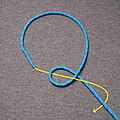Tying
Considered a difficult knot to tie, cowboys were said to have been able to collect a fee for tying it. [5] Ashley went so far as to include it in a chapter covering trick knots in The Ashley Book of Knots stating archly, "the trick is to succeed in tying it." [6]
Many methods have been devised to tie the fiador knot, [7] including fixtures used to hold the parts in shape while tying. [4] [8] More recent sources have shown a simpler method of forming the fiador knot using a flat precursor knot. [9] [10] [11]
The following images show a method for tying the fiador knot:
Tight face and loose face
Careful inspection reveals the two faces of the completed fiador knot, where the four strands emerge, are not identical. One has the appearance of a crown knot surrounding the emerging strands and is somewhat resistant to spreading when they are pulled apart. By comparison, the strands emerging from the other face of the knot are not nearly as well-contained and if pulled apart, the fiador knot easily distorts and splays. Depending on how the fiador knot is tied, these distinct faces can be positioned differently with respect to the side of the knot with the two loops and the side with a single loop and the two free ends.
While most sources fail to discuss and differentiate the two faces, those that do suggest the tight face is best oriented towards single loop and two free ends if the knot is to be used in a rope fiador. [10] [12] The rationale stated is that the single loop and free end side of the knot will be subject to more spreading when it passed around the neck of the horse. By contrast, the strands on the two-loop side of the fiador knot will generally be kept together by the double hackamore knot immediately below it. [13] [14]
Regardless of the original tying method, the orientation of the tight and loose faces can be swapped in the completed knot. [11] By loosening the fiador knot, the tight face can be pressed towards, over, and around the rest of the knot. The knot will invert, "much the same as a mitten is turned inside out." [15] When retightened, the tight and loose faces will have been exchanged.

A knot is an intentional complication in cordage which may be practical or decorative, or both. Practical knots are classified by function, including hitches, bends, loop knots, and splices: a hitch fastens a rope to another object; a bend fastens two ends of a rope to each another; a loop knot is any knot creating a loop; and splice denotes any multi-strand knot, including bends and loops. A knot may also refer, in the strictest sense, to a stopper or knob at the end of a rope to keep that end from slipping through a grommet or eye. Knots have excited interest since ancient times for their practical uses, as well as their topological intricacy, studied in the area of mathematics known as knot theory.

The overhand knot, also known as a knot and half knot, is one of the most fundamental knots, and it forms the basis of many others, including the simple noose, overhand loop, angler's loop, reef knot, fisherman's knot, Half hitch, and water knot. The overhand knot is a stopper, especially when used alone, and hence it is very secure, to the point of jamming badly. It should be used if the knot is intended to be permanent. It is often used to prevent the end of a rope from unraveling. An overhand knot becomes a trefoil knot, a true knot in the mathematical sense, by joining the ends. It can also be adjusted, faired, or mis-tied as a half hitch

The constrictor knot is one of the most effective binding knots. Simple and secure, it is a harsh knot that can be difficult or impossible to untie once tightened. It is made similarly to a clove hitch but with one end passed under the other, forming an overhand knot under a riding turn. The double constrictor knot is an even more robust variation that features two riding turns.
A whipping knot or whipping is a binding of marline twine or whipcord around the end of a rope to prevent its natural tendency to fray.

The Munter hitch, also known as the Italian hitch, mezzo barcaiolo or the crossing hitch, is a simple adjustable knot, commonly used by climbers, cavers, and rescuers to control friction in a life-lining or belay system. To climbers, this hitch is also known as HMS, the abbreviation for the German term Halbmastwurfsicherung, meaning half clove hitch belay. This technique can be used with a special "pear-shaped" HMS locking carabiner, or any locking carabiner wide enough to take two turns of the rope.

Rope splicing in ropework is the forming of a semi-permanent joint between two ropes or two parts of the same rope by partly untwisting and then interweaving their strands. Splices can be used to form a stopper at the end of a line, to form a loop or an eye in a rope, or for joining two ropes together. Splices are preferred to knotted rope, since while a knot typically reduces the strength by 20–40%, a splice is capable of attaining a rope's full strength. However, splicing usually results in a thickening of the line and, if subsequently removed, leaves a distortion of the rope. Most types of splices are used on 3-strand rope, but some can be done on 12-strand or greater single-braided rope, as well as most double braids.
While a spliced 3-strand rope's strands are interwoven to create the splice, a braided rope's splice is constructed by simply pulling the rope into its jacket.

A bridle is a piece of equipment used to direct a horse. As defined in the Oxford English Dictionary, the "bridle" includes both the headstall that holds a bit that goes in the mouth of a horse, and the reins that are attached to the bit.
A halter or headcollar is headgear that is used to lead or tie up livestock and, occasionally, other animals; it fits behind the ears, and around the muzzle. To handle the animal, usually a lead rope is attached. On smaller animals, such as dogs, a leash is attached to the halter.

The Ashley Book of Knots is an encyclopedia of knots written and illustrated by the American sailor and artist Clifford W. Ashley. First published in 1944, it was the culmination of over 11 years of work. The book contains 3,854 numbered entries and approximately 7,000 illustrations. The entries include knot instructions, uses, and some histories, categorized by type or function. It remains one of the most important and comprehensive books on knots.
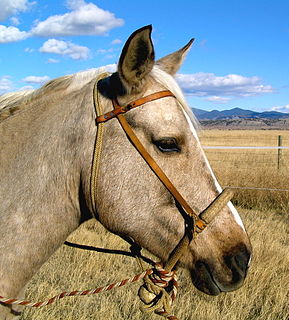
A hackamore is a type of animal headgear which does not have a bit. Instead, it has a special type of noseband that works on pressure points on the face, nose, and chin. Hackamores are most often seen in western riding and other styles of riding derived from Spanish traditions, and are occasionally seen in some English riding disciplines such as show jumping and the stadium phase of eventing. Various hackamore designs are also popular for endurance riding. While usually used to start young horses, they are often seen on mature horses with dental issues that make bit use painful, and on horses with mouth or tongue injuries that would be aggravated by a bit. Some riders also like to use them in the winter to avoid putting a frozen metal bit into a horse's mouth.
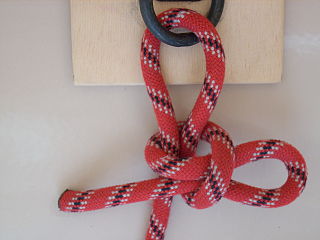
The halter hitch is a type of knot used to connect a rope to an object. As the name implies, an animal's lead rope, attached to its halter, may be tied to a post or hitching rail with this knot. The benefit of the halter hitch is that it can be easily released by pulling on one end of the rope, even if it is under tension. Some sources show the knot being finished with the free end running through the slipped loop to prevent it from working loose or being untied by a clever animal, still allowing easy but not instant untying.
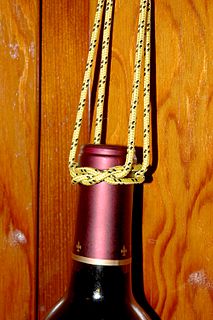
The bottle sling is a knot which can be used to create a handle for a glass or ceramic container with a slippery narrow neck, as long as the neck widens slightly near the top.

The eye splice is a method of creating a permanent loop in the end of a rope by means of rope splicing.

A bosal is a type of noseband used on the classic hackamore of the vaquero tradition. It is usually made of braided rawhide and is fitted to the horse in a manner that allows it to rest quietly until the rider uses the reins to give a signal. It acts upon the horse's nose and jaw. Though seen in both the "Texas" and the "California" cowboy traditions, it is most closely associated with the "California" style of western riding. Sometimes the term bosal is used to describe the entire classic hackamore or jaquima. Technically, however, the term refers only to the noseband portion of the equipment.

A bitless bridle is a general term describing a wide range of headgear for horses or other animals that controls the animal without using a bit. Direction control may also be via a noseband or cavesson, if one is used. The term hackamore is the most historically accurate word for most common forms of bitless headgear. However, some modern bitless designs of horse headgear lack the heavy noseband of a true hackamore and instead use straps that tighten around a horse's head to apply pressure in various ways. These are often specifically patented and marketed as "bitless bridles", usually referencing a particular type of headgear known as the cross-under, though other designs are sometimes also given similar names.

A fiador term of Spanish colonial origin referring to a hackamore component used principally in the Americas. In English-speaking North America, the fiador is known principally as a type of throatlatch used on the bosal-style hackamore. Its purpose is to stabilize a heavy noseband or bosal and prevent the bridle from shifting. It is not used for tying the horse.
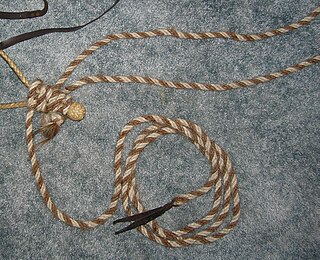
The mecate is the rein system of the bosal style hackamore used to train young horses. It is a long rope, traditionally of horsehair, approximately 20–25 feet long and up to about 3/4 inch in diameter. It is tied to the bosal in a specialized manner that adjusts the fit of the bosal around the muzzle of the horse, and creates both a looped rein and a long free end that can be used for a number of purposes. When a rider is mounted, the free end is coiled and attached to the saddle. When the rider dismounts, the lead rein is not used to tie the horse to a solid object, but rather is used as a lead rope and a form of Longe line when needed.

A lead, lead line, lead rope (US) or head collar rope (UK), is used to lead an animal such as a horse. Usually, it is attached to a halter. The lead may be integral to the halter or, more often, separate. When separate, it is attached to the halter with a heavy clip or snap so that it can be added or removed as needed. A related term, lead shank or lead chain refers to a lead line with a chain attached that is used in a variety of ways to safely control possibly difficult or dangerous horses if they will not respond to a regular lead.

The diamond hitch is a lashing technique used mainly in the field of equine packing, to secure a set of objects, for instance a pair of pack-bags, pack-boxes or other gear onto a base, for instance a pack saddle frame, in which case it requires the use of a lash cinch. In the general sense it requires the base to be equipped with at least two points of anchorage, and a rope which is used to lash the object down onto the base. There are two types of Diamond Hitches, a single, shown here, and a double diamond hitch which is not shown.

